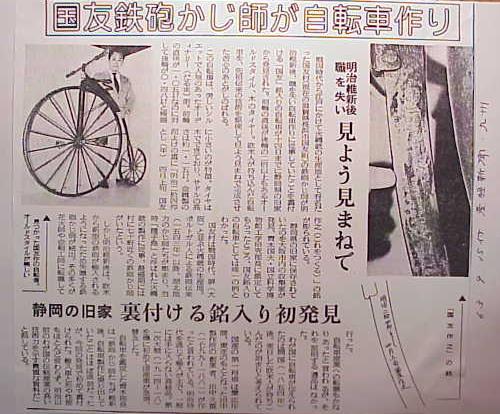
History of the ordinary in Japan.
By Yukio Ootsu
Introduction
Documented information on high wheel bicycles in Japan is extremely scarce. It is quite incomplete and seems quite impossible to prove when the first ordinary appeared in Japan. However it is my life long plan and desire to find out the record. Here are my reports of discoveries at the time being.
Few undated photographs of high wheelers show a proud Japanese participation in the high wheel bicycle era. Actual examples of these bicycles that exist in Japanese museums and a few private collections show a history of both import and domestic blacksmith shop production. The early Ordinaries produced by Japanese blacksmiths locally are apparently at the same step with the world trend of the 1880's.You can tell it form early woodblock prints.
Judging from the information with dates, one can conclude that the high wheel period in Japan had a span of a decade from 1885 to 1895.
Further information may be discovered by bicycle historians of the other parts of the world. It may come, for example, in the form of an old invoice from London, or, San Francisco showing the shipment of an ordinary to Japan. It may say in a ship's cargo manifest. Other sources like export and customs documents from the West could easily help pinpoint date of early high wheel shipments to Japan. These, along with many other documented materials could help significantly to my search.
I appreciate my inclusion in this community of bicycle historians' from all over the world, and, look forward to achieve one unity Bicycle history system some day.
It shall benefit all of us.
Significant Newspaper Item:
I still remember the day my eyes spotted at a news item, it was September 15, 1988. The Sankei newspaper featured the headline "Kuitomo Gunsmith Makes Early Bicycle" (Figure 1)
This bicycle was discovered with an old distinguished family of Shizuoka Pref.; The next revelations were especially important, as the year of manufacturer and place of production are marked on the frame, "April of Meiji 24, (year 1891)at Kunitomo. This identifies the place of manufacturer at Kunitomo. Which is at present the town of Shiga Pref. Nagahama-shi Kunitomo.
Description:
The front wheel of this bicycle is 1.05 meters. The back wheel is 0.48 meters. The height of the saddle not being high, at 1.15 meters. The wheel is made of wood and the tire is an iron belt. There is even a mudguard attached to the front wheel. When it is found, the bicycle was nearly complete. The maker of this early Japanese bicycle is considered to be a gunsmith and it is a fine example of his masterworks of iron.
Some historical notes:
Eisuke Miyata , the founder of Miyata Bicycles was a gunsmith.
Firearms were introduced to Japan by the Portuguese in 1543, and gun production technology soon appeared in the village of Kunitomo. This village prospered with gun production, as in Sakai, according to the demands of feudal lords of the Nobunaga Oda and others., until the end of the age of wars.
Toubei Kunitomo (1778-1840, in the Edo period) who became a blacksmith foreman in 1817 in what was called Ichikansai. He excelled as a scientist and produced the air gun and the reflecting telescope.
At present, the Kunitomo bicycle is on display in the Edo-Tokyo museum in Ryogoku, Tokyo. We can see it in Figure 2.

Figure 1, The news article in the Sankei newspaper dated September 15, 1988.
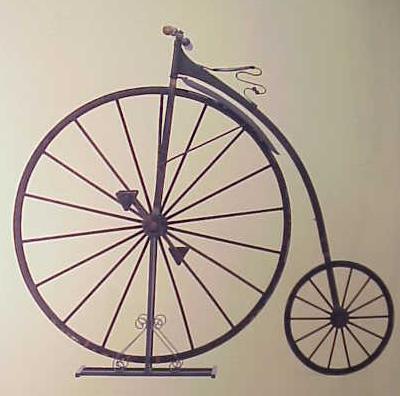
Figure 2, Ordinary on display in the Edo/Tokyo museum.
The Dharma - The name for the Ordinary style bicycle of Japan:
The Dharma bicycle is generally considered the Ordinary style of bicycle in Japan. The adoption of this name originated because it resembles in the form that laid. Dharma. It is, needless to say, the highly reputed monk who prepared the foundation of Chinese Zen sect. He was born in India and reached China by sea route in the year 470. He studied in the Mount Songshan Shao-ling temple. The figure called Dharma shows the form how he meditated. After that, people believed that this figure make a happy charm. The Japanese feel familiarity to this Dharma, and sign of exceptional good luck.
Japan's first Bicycle Club?
Four men by the names of Tanakadate, Sawai, Hirota, and Wada established a bicycle club, they were attending the college of Imperial University. This is an article appeared on March 28, 1886, in the Chouya newspaper. Was this the first Bicycle Club in Japan? At this time, it is not known for sure, but certainly they were early riders.
Tanakadate, who was the member in that early time was quoted in the following in the year. "Bicycle of recent, but not the style of a chain drive, the front wheel is big, the back wheel is small. It reminds me of riding a horse. (He seems to have experienced riding a horse.) All the members raised money and purchased and shared one bicycle. We used this bicycle as exercise equipment. Rubber tires, etc. are a luxury, but the bicycle that we bought was a stubborn thing of wood, with an iron wheel."
As shown in this conversation, the bicycle was of the High Wheel design. Obviously, it was not the latest model constructed of steel and rubber tires. It is clear in stating that it was an old fashion wooden machine. Was it made in Japan or a foreign? This is not apparent, but I presume it was made in Japan. By this time period, Japan had already mastered making bicycles, and iron belted wooden wheels were quite prevalent. If the bicycle had been equipped with rubber, it would more strongly indicate an imported bicycle. Another important point is that this may have been the first bicycle club established in Japan. This loosely knit group of students may have been Japan's first bicycle club, preceding the "The Japan Bicycle Friend Club" by 7 years.
It is generally accepted that first documented Japanese bicycle club is "The Japan Bicycle Friend Club". This club was inaugurated in Meiji 26 (1893). However, the Empire University Club that was introduced earlier, was getting active. When you compare the Empire University Club to the latter "Japan Bicycle Friend Club", the "Japan Bicycle Friend Club" seems to be the first documented.
In examining the following:
An article from the bicycle specialty magazine, "The Cycle Friend"That is on March 10, in Meiji 36, (year 1903), Ishikawa, a former member was reflecting that earlier time in saying " I think the "Japan Cycle Friend Club" was probably organized in the earliest period." There were many Dharma bicycles, wooden two wheeled bicycles and tricycles. The article points out that the Dharma bicycle was still in the mainstream about Meiji 26 (1893), and that the chain driven safety bicycle was still in the minority.
In the next article, there is an interesting episode of High Wheel riding. The machine is described as having a wheel of about 60 inches. "He was riding his Ordinary at high speed, and because of a sharp pull on the handles it crashed against a shop. Being dislodged, the rider fell through the shop ceiling.
The old woman in the shop was very much surprised."
Recent interest in the Ordinary
When I was young, I saw the movie, "Around the World in 80 Days" (based on a Jules Vernes classic novel). Most likely, everyone has seen this movie.
There was a scene familiar to all early bicycle enthusiasts, that of Passepartout getting on the bicycle in this movie. This scene is not in the original book version, and mounting from a street lamp post, as opposed to using the mounting step leaves one to wonder. The era of the novel is set in 1872. This era is the earliest stage for Ordinary, but not for the type that Passepartout was getting on.
Fifteen years passed, in 1886, a young American named Thomas Stevens, started around the world on a High Wheel bicycle. He arrived in Japan in 1886. Quoting a newspaper from that time, The Jijishinpou Newspaper, dated December 4, 1886). Thomas Stevens arrived in Nagasaki by ship (the name of the vessel was the Yokohama-maru). He left Nagasaki on December 23rd by bicycle on an overland route towards Kobe. He is scheduled to return to America by ship from the port of Yokohama. Stevens' had left from New York in April of the previous year, heading for England.
The Thomas Stevens ride across Japan was a sensational topic of its time. As I was not introduced to bicycle history until recently, I need to evaluate his achievement with care. I think that his influence on the Japanese was significant. Many Japanese looked at him who runs Toukaidou road on a bicycle as a scene of curiosity.
Even Yoshinobu Tokugawa whom we introduce in the next chapter would have seen it.
Shogun on a Bicycle.
Yoshinobu Tokugawa spent sufficient time engaged in hobbies. He especially liked new things. The high bicycle was still novel, and mounting was a spectacle that most Japanese had not seen.
The kind of bicycle that Yoshinobu Tokugawa mounted may have been a Columbia, much like the Thomas Stevens machine he had seen a year earlier, but no photograph exists An article in the newspaper (Feb. 5, 1887 Shizuoka Daimu Newspaper) stated that he ordered a bicycle promptly. Once he gets the high bicycle, he rides it daily, with his servant trailing on foot. He eventually compensated his servant to replace his worn shoes, as this was written in the diary of the servant.
Also, even Kamejirou Matsumoto who was in Shizuoka at that time was witnessing this event. The following was noted in his diary.
"It is fine weather on January 13, in Meiji 20(year 1887). On the occasion of my 2 O'clock walk, I saw Tokugawa general and two nobles walk through town with a bicycle."
The two nobles that appear here are the brother of Ietatu Tokugawa and Akitake Tokugawa.
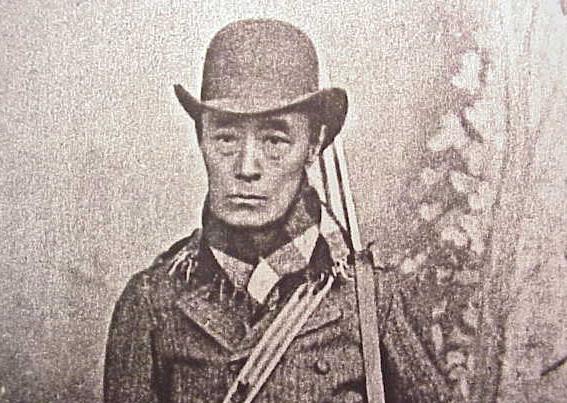
Figure 3, Yoshinobu Tokugawa
People who loved the Ordinary (bicycle).
There was the following episode
He was practicing with his ordinary on Mitsubishi open field. He entered Wadakura gate of the Imperial Palace, his riding posture showing self-confidence and pride. Then, a high-ranking Government official passed in a carriage. In letting the carriage pass, Kitamura leaned on the stone wall of the Imperial Palace. Unfortunately, the inclination of his body was such that he could neither dismount nor resume riding. He was painfully trapped on his bicycle, his head wedged against a wall of stone. As there was little pedestrian traffic, he remained trapped, unaided for over an hour. At last, a servant of the shrine passed by, asked of his predicament, and he was rescued.
Next, even the brother that introduces it is an enthusiastic bicycle lover. The time is Meiji 21 (year 1888).
The brother of Kaisaku Morimur and Meiroku purchased an Ordinary made by the Gormully and Jeffrey Company of America. He used the bicycle for attending school, and for recreational cycling on Saturday and Sunday.
He planned a magnificent trip, as stated in Tokaido cycling in Meiji 26,(year 1893).
"He left Tokyo, Takanawa on May 10, an outward trip using the train. The return trip from Kobe was exclusively by bicycle". The biggest and most dangerous path was Hakone crossing. In the morning, he left Okitsu,traveling towards Mishima. Time passed rapidly to 3 o'clock in the afternoon. The sun was starting to set early as he climbed Hokone, and conditions worsened as rains set in. For the dangerous decent, he tied a rope to the backbone to drag a heavy object behind him. This, in conjunction with using the spoon brake, slowed his decent down the long dangerous slope. He finally arrived at Yumoto, it was passed 9 PM at night.
This article was published in "Rin yu (The Cycle Friend)" an issue of Meiji 34, (year 1901)
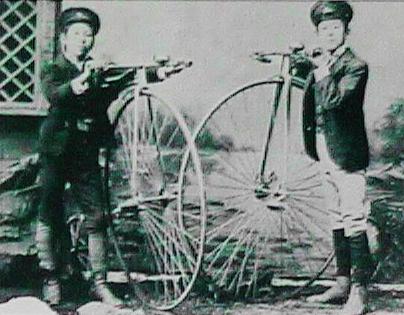
Figure 4, shows the Morimura brothers with their Ordinaries
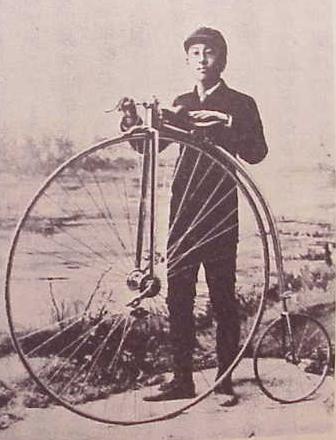
Figure 5,Kaisaku Morimura
Early Japanese Bicycle Maker
Source: The Mainichi Newspaper on February 1 in Meiji 22.(year1889)
Kajino had an advertisement for an Ordinary in this newspaper. Kajino was an early bicycle maker in Japan and produced his bicycle in Yokohama, in Meiji 12year.(year 1879) There is one hint in this newspaper advertisement, although I have not yet identified what kind of bicycle Kajino was making, but it deserves attention. The one that is depicted here is of the latest design for that time in being made of steel, as with the Ordinary in the West. When you see the Ordinary of Japan in this time period, the wheels are made of wood. You do not normally see the wire spokes as shown in this drawing. You would have to assume that the manufacturer had mastered a fairly advanced technology if Kajino is producing an Ordinary like this. Yet, I am not able to assert that Kajino did not make a bicycle of all steel. Kajino may have produced an all-steel Ordinary and it may have lost in the world war U.
In addition to Kajino, there was the Teikoku(Imperial) bicycle production factory, etc.
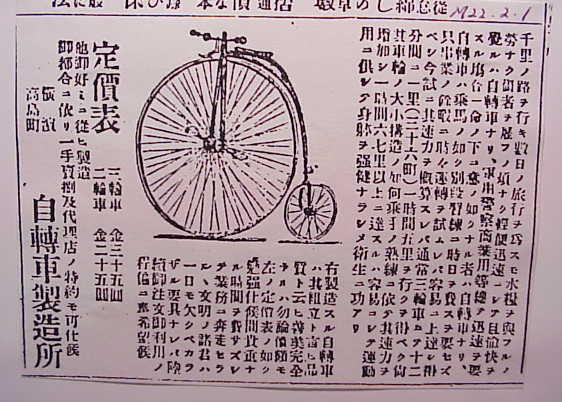
Figure 6 ,February 1, 1889 the Mainichi News Papers
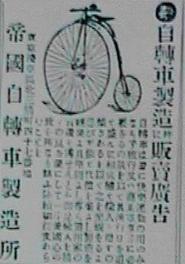
Figure 7,TEIKOKU bicycle production factory. A TyouyaNewspaper advertisement. Dated: January 7, 1888.
The Adoption of the Bicycle in Army and Postal Service.
Military
In both the Army and the Post Office, the bicycle was adopted at an early time. As nearly every invention was considered for possible military or other applications, the bicycle was no exception. In Meiji 29(year 1896), "The Bicycle Means" was issued to try "the cycle" on military affairs in our country. It had already seen service with the Military Police.
It is in Meiji 25(year 1892) that Lieutenant Nakajima brought three types of bicycles into a test in the field. He conducted the test on the exercise grounds. The safety bicycle, equipped with the fragmented chain produced the best results.
"The Jijishinpou "newspaper, October 23, in Meiji 25.(year1892)
This article describes the test for military bicycle use, it had already been adopted for military use with orderlies in foreign countries. The Army Lieutenant, Nakajima has studied abroad for several years. He also enjoyed testing the bicycles, as the parade ground was very flat. It is in Meiji 25.(1892year), and, the tests were conducted on the field exercise fields. Of the 3 types tested, the fragment chain safety bicycle, the latest of its time, produced the best result.
He brought 3 bicycles for testing. Simple two-wheeled Ordinary bicycle (Application in the Western countries) Fragment chain safety bicycle (Nakajima built) Simple safety bicycle (France for military use)
The Ordinary had wheels measuring 48 inch and 18 inch, respectively. The fragmented chain safety bicycle and the simple bicycle had wheels of 28 inches. They were ridden for about 10 hours continuously, at speeds of about 10 miles per hour on a flat road. As for the Utsunomiya demonstration, the speed was not maintained because of ground mud. This progress was reported in the Military Affairs communication.
A photograph remains of the Ordinary, but origin of the fragmented safety chain bicycle is not known. Postal Service It is said that in Meiji 25, (year 1892) that it adopted the bicycle for the first time in the Post Office. In "the service preparation" of Tokyo mail telegraph office, with the illustration of the Ordinary style bicycle and delivery person. Also, the bicycle was used for the transmission of the "ministry's annual report" in Meiji fiscal year 28(year 1895). There, the Safety type, the Dharma (Ordinary type), and Wooden type have been discussed.
Postal Service
Even the Post Office where these bicycles were stationed were few. There were just 4 Post Offices using 56 bicycles, located in Tokyo, Osaka, Yokohama, and Nagoya. At first it was used mainly in telegram delivery. I think that the kind of the bicycle that was adopted first in Post office was ordinary style.
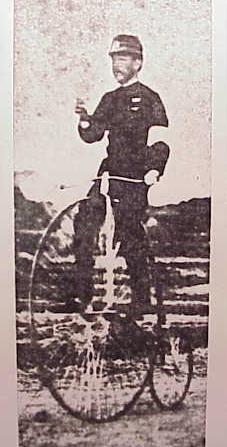
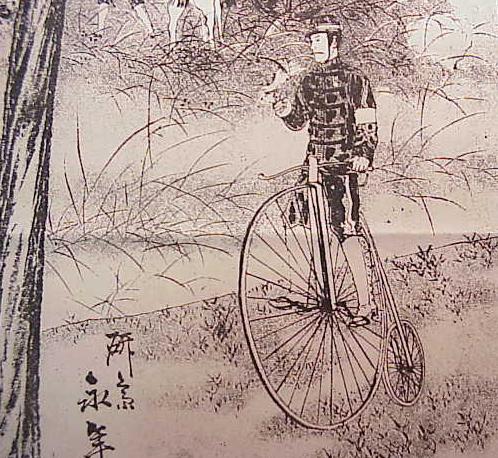
Figure 8 / Figure 9 Picture on the right side: It is Issued on June 10, 1893, "FUZOKU GAHOU".
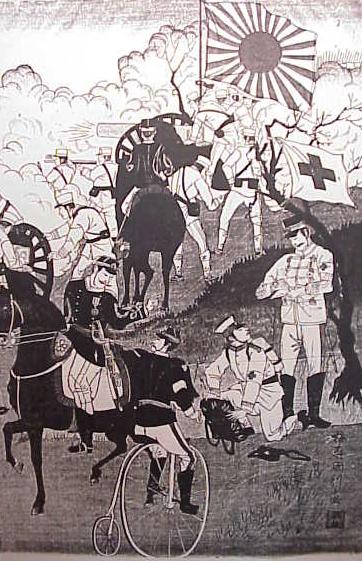
Figure 10 The illustration depicted a large army exercise at Utsunomiya in 1892. It shows a bicycle correspondent in the picture.
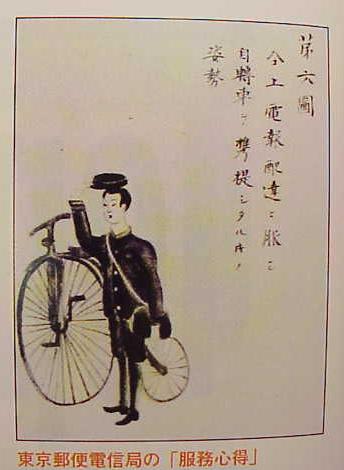
Figure11,Ordinary and Post man
The Nishikie color print that is the traditional art of Japan.
The Nishikie color print that painted the ordinary style bicycle commonly exists. Especially Meiji 25(year 1892) it is frequently painted.

Figure 12, Shows the Azuma bridge scenery in Tokyo in the year1889.
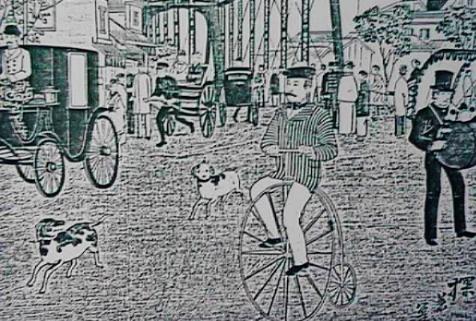
Figure 13,"Azumatei"Tankei was a picture taken in the year 1888.
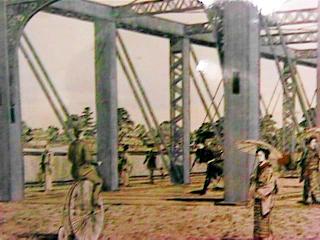
Figure 14, Azuma Bridge, about 1888. The Azuma Bridge was a modern steel bridge at that time.
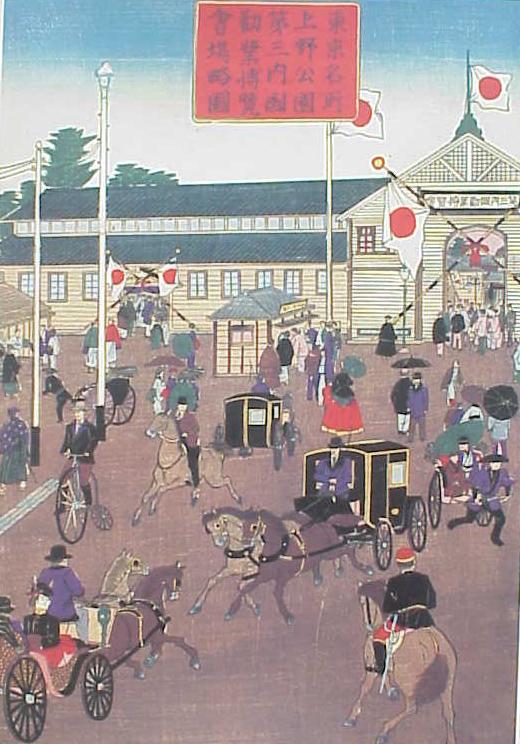
Figure 15 "The 3rd Tokyo Ueno park domestic area for the encouragement of industry exhibition grounds - a rough sketch"
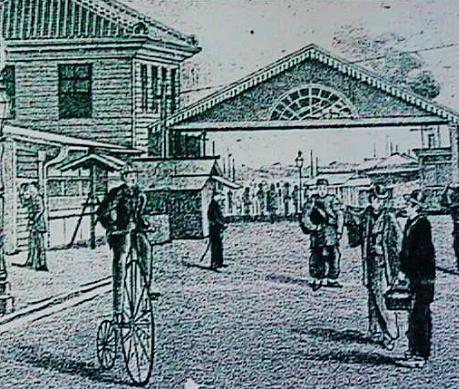
Figure 16, This picture depicts port of Yokohama. Year 1891.
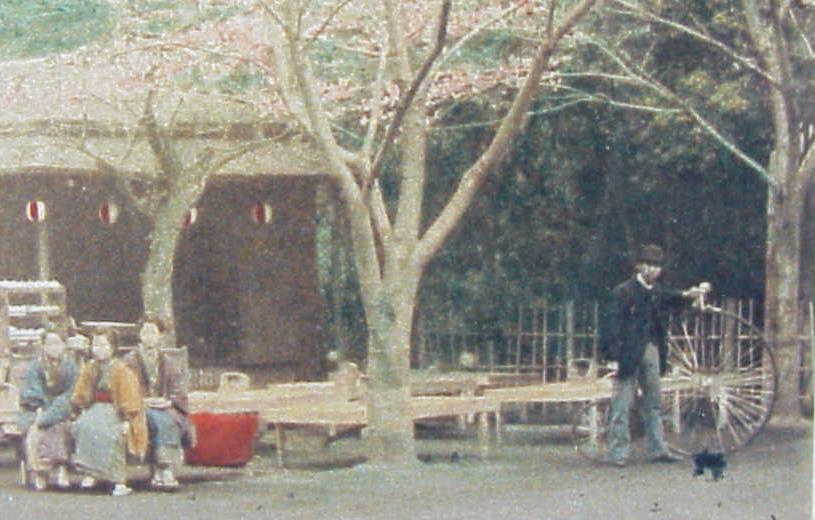
Figure 17, There are few Ordinary bicycle photographs from this era in Japan. There is 1 sheet of photographs here. It is written on this photograph as the teahouse of Tokyo, Ueno. Year not identified.
Other depictions
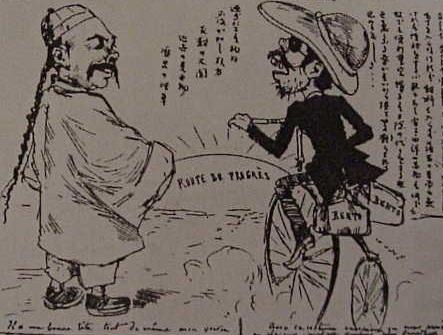
Figure 18, Cartoon that Georges Bigot was a picture ,1888
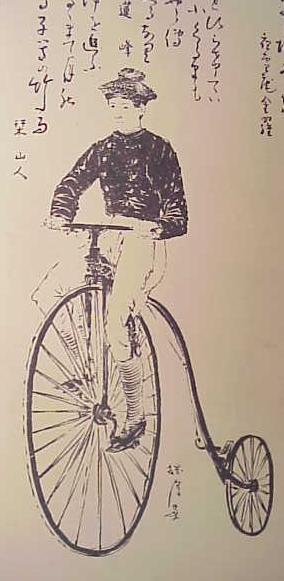
Figure 19,"Customs pictorial" 1889
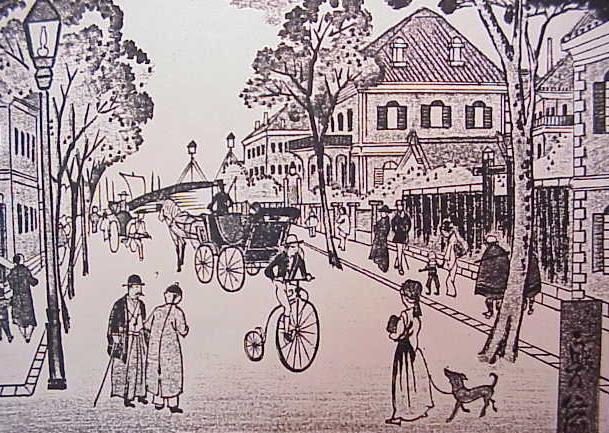
Figure 20, Kawaguti Settlement, year 1885?
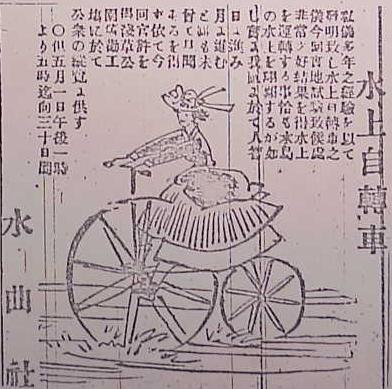
Figure 21,The MesamasiASurface of the water bicycle of Suikyokusya, 1887
Ordinary Style Bicycles Still in Existence.
In March of 1978. The Meiji bicycle exhibition was held in the bicycle culture center located in Tokyo, Akasaka. The fine display of bicycles exhibited here, were from all over Japan. Even rare bicycles that there was not previously available for viewing were on display. 13 ordinaries were displayed, area backgrounds and places of production were discussed.

Figure 22, The possession of Shirou Tanimura. Shiga Pref. The manufacturer's name and the year made are not identified.
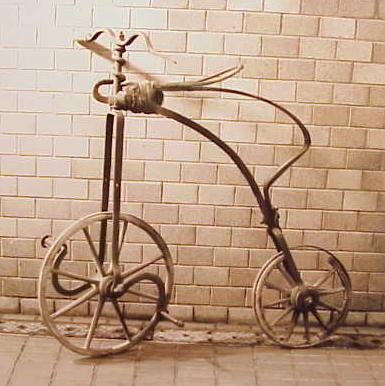
Figure 23, The possession of Seki-cho.Mie Pref. The manufacturer's name and the year made are not identified.
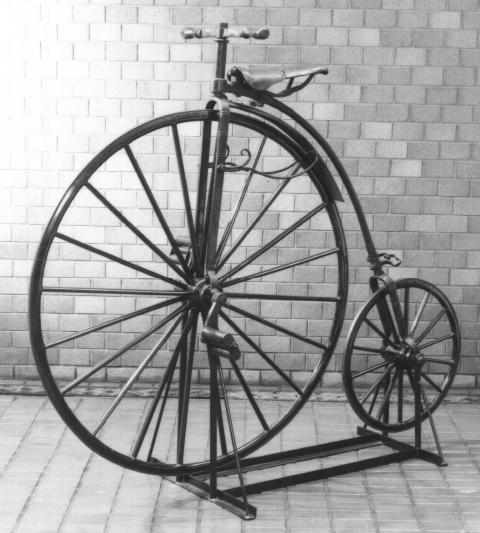
Figure 24, This bicycle was made in Japan, circa 1887. This bicycle is in beautiful condition. It is thought to have been hand crafted in a blacksmith's shop.

Figure 25, The possession of the Yoshida bicycle production co. Tokyo. The manufacturer's name and the year made are not identified.

Figure 26 ,The possession of Sadao Takiguchi. Shizuoka Pref. The manufacturer's name and the year made are not identified.

Figure 27, The possession of Showa industry co. Aichi Pref. The manufacturer's name and the year made are not identified. The front wheel is 41inches.
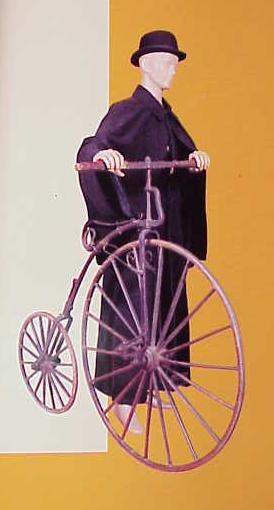
Figure 28,Handa-shi museum. The manufacturer's name and the year made are not identified.
Other bicycles
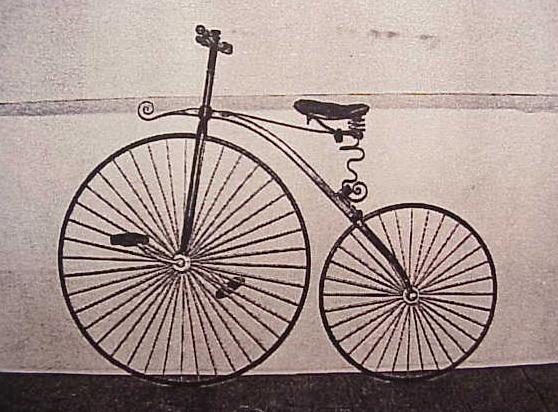
Figure 29, Bicycle of the Kuchinotsu-cho historical folk museum. Is it thought as the one that is about Meiji 18?(1885year?)
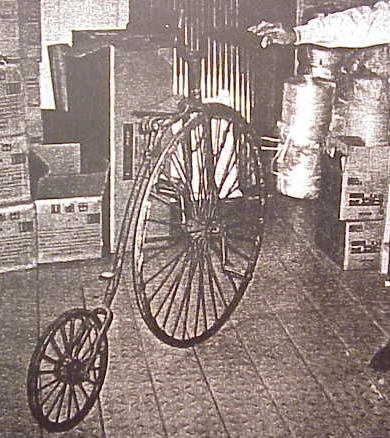
Figure 30, The ordinary bicycle that appeared on TV". Nandemo Kanteidan(Antique evaluation show)".July 13, 1999. I do not understand the production year and maker of this bicycle. The price at this time was 300,000 yen. It is about $ 3,150. (USD). I thought that the machine was too much undervalued.
The characteristic made in Japan; (notes on figures 22 to 30)
Generally, these bicycles were of small size, 30 to 40", corresponding to the physique of the Japanese at that time. The finish is japan (layered japan lacquer), and the mudguard brace possessed an arabesque pattern.
This form shows progressive technology, yet as with many bicycles, no brake was present. This is one of the few period bicycles made of metal, it is of closed head design. The place of manufacturer, manufacturer's name and date produced are not clearly known. All the information was lost in the chaos of the world War U.
End of comments on Ordinary.
It is from Meiji 25,(1892year) that the safe model bicycle was imported in Japan. It was noted in the magazine called 'the friend of hunting', in the issue of June of Meiji 26.,(1893year).
"As with the bicycle newly prevailing, the front wheel is not as large as with the Ordinary one. The wheel has a 28"diameter. This style allows for less frequent accidents, yet, according to the magazine, few of these bicycles were sold. These bicycles were introduced during the conversion period when trends moved from the Ordinary to Safety Bicycles.
Final chapter
The Ordinary had a brief history in Japan, perhaps only 10years. I've concentrated on the data from 1885 to 1895. Ten years is a short period, but the Ordinary has made a lasting contribution to Japan's bicycle history. I think that gradually, new information will come to the surface.
My conclusion in this research: When we think of the silhouette of the bicycle; even today, that beautiful design of the Ordinary bicycle often comes to mind. The reason may be why this silhouette gives the fundamental image of "the bicycle".
Future subjects; (Listing only the item)
The clarification in the producing district, production maker name, production year.
The progress of processing metal technology.
The change of the industrial structure.
The progress of coating technology.
The progress of engineering the components.
The progress of design.
The economic effect.
The influence to other traffic facilities.
The traffic rule, trouble, accident tax, etc.
With this, with my talk ends. Thank you.
Notes
1. Meiji;This is an emperor calendar.
2. Sakai [city]The address that this conference is carried out. The city of Osaka Pref. middle department. The self-governing city by the guidance of prosperity, wealth quotient was formed as the center of the foresight trade to the Muromachi era. Becoming the tradition industry of cutlery and textile with a part of the Osaka and Kobe industrial district that is mainly concerned with development, metal, machine, textile, food industry to the base as the modern age industrial city thereafter, Meiji, even the iron mill, petrochemical complex advanced by the development of the coastal industrial region centering around the Port of Sakai. In (1995) 802,965 people.
3. Nobunaga Oda;@1534-1582,The feudal lord in the age of wars.
4. Imperial University; Present Tokyo University
5. Kamejirou Matsumoto; Pedagogist
Bibliography
"The Kafu diary", 1887
"The Kamejirou diary" Kamejirou Matsumoto, 1887
"The handcart of learn" Tenrinkan, 1889
"Customs pictorial" 11th, 168th, 178th 1889 - ?
"Means of the bicycle "by Shujrou Watanabe 1896
"The exercise world" magazine 1902 from 1900
"The junior high school world" a monthly magazine, From number 3 to number 4, 1898
"The bicycle" a monthly magazine, 1900 - ?
"The cycle friend" a monthly magazine, 1901 - ?
"The bicycle complete book" by Singen Matsui, 1902
"The bicycle guideline" by Umezu lieutenant, 1902
"Cycle world recollection record" by Hanzan Satou , 1927?
"The 1st century of the bicycle" bicycle industrial promotion organization volume 1973
"The history bicycle of the invention" by Yuji Sano, 1980
"Bicycle data table" Japan bicycle history research club, 1985
"The cultural history of the bicycle" by Yuji Sano, 1985
"The element of the bicycle/machine" Inax corp. booklet 1988
"The bicycle culture center place warehouse table" 1992
"The cultural history of the track" by Toshihiko Saitou , 1992
"The bicycle history of Japan" Bicycle culture center volume 1993
Acknowledgments
My deepest thanks to these individuals who provided assistance in the preparation of this document.
Michael Brien, Yuji Sano, Morihiko Imai, Toshio Kajiwara, Takao Ono, Keizou Kobayashi, Ryuji Shibuya, Toshihiko Saitou, Shirou Yagami, Hiroshi Nakamura, Kenji Miwa, Shigeo Suga, Donald Speden, and Kazusuke Koike.
This page was last updated on Aug.29,2000.